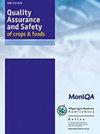Structural changes of cellulosic polysaccharides in sesame hull during roasting at various temperatures
IF 5.3
3区 农林科学
Q1 FOOD SCIENCE & TECHNOLOGY
引用次数: 4
Abstract
This article reports a study of the degradation of roasted sesame hulls cellulosic polysaccharides contribution to the Maillard and caramelization reaction. In the present study, cellulosic polysaccharides were extracted from sesame hulls before and after roasting at various temperatures (160, 180, 200, and 220 °C). The structural variations of the cellulosic polysaccharides were elucidated by using the techniques: scanning electron microscope (SEM), high-performance anion-exchange chromatography, Fourier transform (FT-IR) spectrometer, carbon-13 nuclear magnetic resonance (CP/MAS 13C-NMR), and thermal gravimetric analysis. The pyrolysis-gas chromatography-mass spectrometry (Py-GC/MS) characterized and verified the chemical composition obtained from the polysaccharide degradation during roasting. The sugar analysis results showed that galacturonic acid, xylose, and rhamnose were more easily degraded than arabinose, galactose, glucose, and mannose. The morphology of the cellulosic polysaccharides shows irregular dispersed globular fragments after roasting by SEM observation. FT-IR and CP/MAS 13C-NMR spectra indicated the crystalline structure and linkages of the cellulose did not break down in comparison to amorphous cellulose that partly degraded. Abundant acetic acid and 3-furaldehyde were among the polysaccharide degradation products identified by Py-GC/MS. These chemical compounds were likely the significant contributors to caramelization and the Maillard reaction in sesame seed roasting.芝麻壳中纤维素多糖在不同温度焙烧过程中的结构变化
本文研究了芝麻壳纤维素多糖对美拉德和焦糖化反应的降解作用。在本研究中,在不同温度(160、180、200和220°C)下烘焙前后,从芝麻壳中提取纤维素多糖。利用扫描电子显微镜(SEM)、高效阴离子交换色谱、傅立叶变换(FT-IR)光谱仪、碳-13核磁共振(CP/MAS 13C-NMR)和热重分析等技术对纤维素多糖的结构变化进行了表征。热解气相色谱-质谱(Py-GC/MS)对焙烧过程中多糖降解得到的化学成分进行了表征和验证。糖分析结果表明,半乳糖醛酸、木糖和鼠李糖比阿拉伯糖、半乳糖、葡萄糖和甘露糖更容易降解。通过SEM观察,纤维素多糖在焙烧后呈现不规则分散的球状碎片。FT-IR和CP/MAS 13C-NMR光谱表明,与部分降解的无定形纤维素相比,纤维素的晶体结构和键没有分解。Py-GC/MS鉴定的多糖降解产物中含有丰富的乙酸和3-糠醛。这些化合物可能是芝麻烘烤中焦糖化和美拉德反应的重要因素。
本文章由计算机程序翻译,如有差异,请以英文原文为准。
求助全文
约1分钟内获得全文
求助全文
来源期刊

Quality Assurance and Safety of Crops & Foods
FOOD SCIENCE & TECHNOLOGY-
CiteScore
4.60
自引率
7.50%
发文量
61
审稿时长
1 months
期刊介绍:
''Quality Assurance and Safety of Crops & Foods'' is an international peer-reviewed journal publishing research and review papers associated with the quality and safety of food and food sources including cereals, grains, oilseeds, fruits, root crops and animal sources. It targets both primary materials and their conversion to human foods. There is a strong focus on the development and application of new analytical tools and their potential for quality assessment, assurance, control and safety. The scope includes issues of risk assessment, traceability, authenticity, food security and socio-economic impacts. Manuscripts presenting novel data and information that are likely to significantly contribute to scientific knowledge in areas of food quality and safety will be considered.
''Quality Assurance and Safety of Crops & Foods'' provides a forum for all those working in the specialist field of food quality and safety to report on the progress and outcomes of their research.
 求助内容:
求助内容: 应助结果提醒方式:
应助结果提醒方式:


